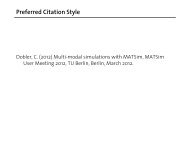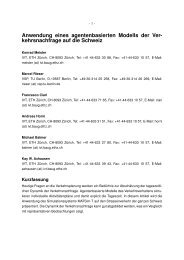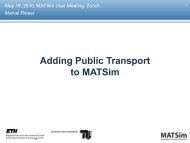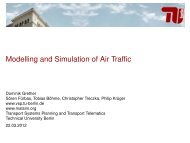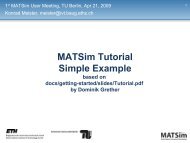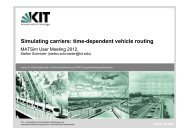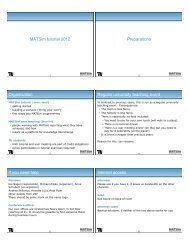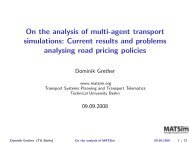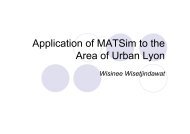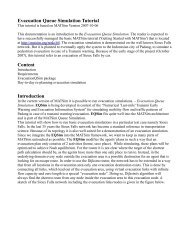LARGE-SCALE PARALLEL GRAPH-BASED SIMULATIONS - MATSim
LARGE-SCALE PARALLEL GRAPH-BASED SIMULATIONS - MATSim
LARGE-SCALE PARALLEL GRAPH-BASED SIMULATIONS - MATSim
Create successful ePaper yourself
Turn your PDF publications into a flip-book with our unique Google optimized e-Paper software.
t y p e d e f multimap- Time , Veh WaitQueue ;<br />
WaitQueue waitQueue ;<br />
t y p e d e f multimap- Time , Veh ParkQueue ;<br />
ParkQueue parkQueue ;<br />
Figure 3.8: Declarations for waiting and parking queues with the STL-multimap<br />
t y p e d e f Linked- Time , Veh WaitQueue ;<br />
WaitQueue waitQueue ;<br />
t y p e d e f Linked- Time , Veh ParkQueue ;<br />
ParkQueue parkQueue ;<br />
Figure 3.9: Declarations for waiting and parking queues with linked lists<br />
queue is not full, the vehicle is moved from the waiting queue into the spatial queue so that it<br />
can start its trip.<br />
Hence, in each time step, waiting and parking queues are checked for the eligible vehicles.<br />
In realistic scenarios, most of the vehicles wait in these queues because their drivers are actually<br />
performing an activity. Checking for all eligible vehicles and accessing their information and<br />
moving them to other queues when necessary comes with computational cost. Therefore, an<br />
appropriate data structure should be used for these queues. That data structure needs to make<br />
available the vehicle with the next scheduled departure at low performance cost. For this, a<br />
partial ordering would in fact be sufficient. However, there is no data structure in the STL<br />
which supplies a fully efficient partial ordering. Therefore, two fully ordered data structures<br />
were tested: the STL-multimap, and a self-implemented singly linked list.<br />
Note that this section only discusses waiting and parking queues. Data structures for link<br />
cells will be explained in the next subsection.<br />
Multimap<br />
An easy-to-use fully sorted data structure is the STL-multimap. One just inserts key-item<br />
pairs, with the keys equal to the start time of vehicles and the items being pointers to vehicles,<br />
and the resulting data structure is automatically sorted. The difference between the STL-map,<br />
as mentioned above, and the STL-multimap is that the latter accepts multiple elements for<br />
the same key. This is necessary since it is possible that several vehicles want to depart at the<br />
same time step. The declarations by using STL-multimap are given in Figure 3.8.<br />
User-defined singly linked list<br />
There are three operations defined on these queues: Insertion of an element into a queue, retrieving<br />
the first element of the queue, and deleting the first element of the queue. Unfortunately<br />
these operations are rather costly with the STL-multimap. From the experiences in the C<br />
version of the simulation where a linked list was been used for these queues, a linked list is<br />
implemented also in the C++ version to handle waiting and parking queues.<br />
The Linked class in Figure 3.9 represents a singly linked list where each item in the list<br />
has a pointer to the next item. Insertion at the end of the list and insertion according to a key<br />
value into the sorted list are available. The latter is important so that vehicles can be sorted<br />
according to their start times.<br />
25



